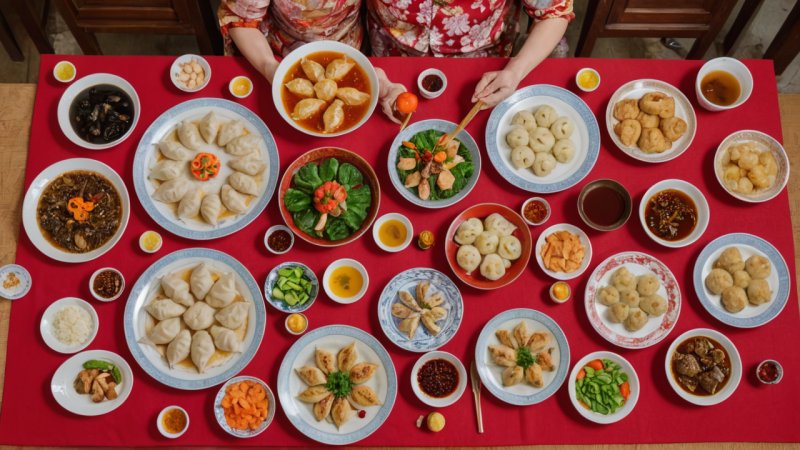As the lunar calendar turns, millions of people around the world prepare to welcome the Chinese New Year, a time steeped in rich traditions and vibrant celebrations. Among the most integral aspects of this festive occasion are the dishes that adorn the tables of families and communities, each imbued with symbolic meanings and ancestral significance. From savory dumplings to sweet rice cakes, the culinary offerings during this time are more than just food; they represent a blend of history, culture, and hopes for the future. This article delves into the flavors of Chinese New Year, exploring traditional dishes, their meanings, and how they bring people together in celebration.
Symbolic Dishes for Prosperity and Good Fortune
During Chinese New Year, each dish served carries a deep-rooted significance, often reflecting wishes for the coming year. One of the most iconic dishes is dumplings (饺子, jiǎozi), which are traditionally shaped like ancient Chinese gold ingots, symbolizing wealth and prosperity. Families often gather to make these dumplings together, reinforcing family bonds while preparing for the feast. It is common for families to hide a coin inside one of the dumplings, and whoever finds the coin is believed to have good luck for the entire year.
Another dish that holds great significance is fish (鱼, yú). The pronunciation of the word for fish is similar to the word for surplus, symbolizing abundance. It is customary to serve a whole fish, often steamed with ginger and scallions, and to leave some uneaten, as it is believed that this will ensure prosperity in the coming year. The act of serving fish is a reminder to cherish the past year while looking forward to the blessings that lie ahead.
Sweet Treats for a Sweet Life
No celebration is complete without desserts, and Chinese New Year is no exception. Glutinous rice cakes (年糕, niángāo) are a must-have, symbolizing progress and growth. The sticky texture of the cake represents unity and togetherness, making it a perfect treat for family gatherings. Often, these cakes are fried or steamed, served with various fillings such as red bean paste or sweetened coconut.
Another dessert that is popular during this time is tangerines (橙, chéng), which are often exchanged as gifts due to their auspicious symbolism of good luck and wealth. The bright orange hue of tangerines is reminiscent of gold, making them a fitting gift for friends and family. Additionally, sweet rice balls (汤圆, tāngyuán) are enjoyed for their round shape, representing family unity and completeness. Typically filled with sweet sesame or peanut paste, these treats are often served in a warm syrup during family reunions, further emphasizing togetherness.
Regional Variations and Unique Flavors
While certain dishes are staples across Chinese households, regional variations add a unique flair to the New Year celebrations. For instance, in northern China, jiaozi (dumplings) take center stage, while in southern regions, people may favor spring rolls (春卷, chūnjuǎn), which symbolize wealth due to their gold-like appearance. Each region boasts its own specialties, with ingredients and cooking methods that reflect local traditions and flavors.
In some parts of China, you may find peking duck served during celebrations, a dish renowned for its crisp skin and tender meat. In contrast, the Sichuan region may present spicy dishes that embody the bold flavors of their culinary style. This diversity not only showcases the rich culinary heritage of China but also highlights the cultural significance of sharing food during the New Year festivities.
The Importance of Family and Togetherness
The essence of Chinese New Year is not solely in the dishes served but also in the act of gathering around the table. Families often travel long distances to reunite, making the New Year’s Eve dinner one of the most important meals of the year. This gathering serves as an opportunity to honor ancestors, share stories, and create new memories while indulging in the symbolic dishes prepared with love.
Many families also partake in reunion dinners (团圆饭, tuányuánfàn), where they prepare a feast featuring all the traditional dishes. These meals go beyond mere sustenance; they are a celebration of familial ties and cultural heritage. Each bite is a reminder of the past and a toast to the future, with hopes for health, happiness, and prosperity.
Tips for Enjoying Chinese New Year Dishes
For those looking to immerse themselves in the flavors of Chinese New Year, here are some tips:
- Join a family gathering: If you have the opportunity, try to join a local family celebration. This is an excellent way to experience authentic dishes and the traditions that accompany them.
- Explore different regions: Taste dishes from various regions to appreciate the diversity of flavors and cooking styles. Each region offers unique interpretations of traditional dishes.
- Cook at home: Consider preparing some of the traditional dishes at home, using recipes that have been passed down through generations. This can be a fun activity to share with friends or family.
- Learn the meanings: Familiarize yourself with the symbolic meanings of the dishes you encounter. Understanding the importance behind the food adds depth to your culinary experience.
In conclusion, celebrating Chinese New Year through its traditional dishes is a delightful journey that combines rich history, cultural significance, and family unity. Each dish tells a story, symbolizing hopes for prosperity, health, and happiness in the coming year. As you partake in this festive season, remember that it is not just about the flavors on your plate, but also the connections made around the dining table. Embrace the traditions, savor the moments, and may your New Year be filled with abundance and joy.






